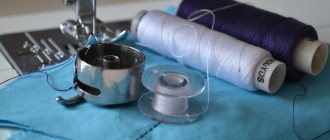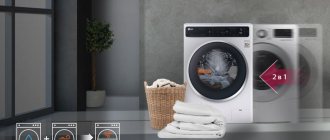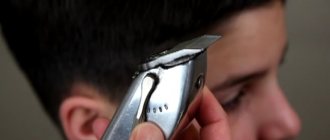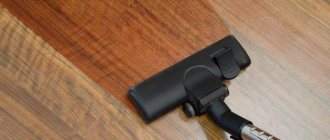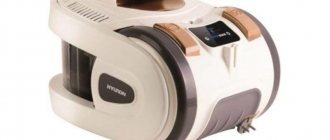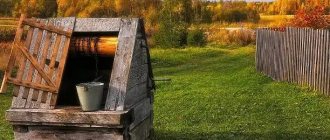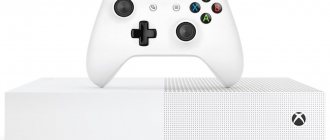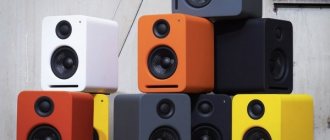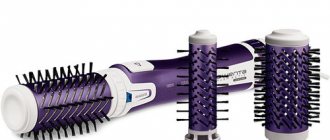Today, there are different types of sewing machines on the household appliances market, each of which has great functionality. Essentially, manufacturers have reached the same heights in their design (they just went about it in different ways, as a result, their products differ in a set of unique features).
In this article we will talk about the characteristics and features of the equipment, and the companies that produce it. This information will help you purchase a device that meets all your preferences.
General characteristics of modern sewing machines
Before comparing devices with each other, it is necessary to talk about their common features. We will only talk about electric-powered machines, and not about manual or foot-operated mechanical ones.
All new types of devices have a light plastic or lightweight metal body . This makes them no less reliable, since there is a frame inside. Chassis parts are still made of metal.
Modern devices are highly powerful . They easily sew through thick fabric, even folded in several layers. They also cope with leather, but there’s no need to talk about light materials (silk, knitwear, etc.). Power is one of the main requirements for technology.
Sewing speed is also considered an important characteristic . Over the past few years, it has increased noticeably: it began to be regulated by the force of pressing the pedal or set to special modes. All units now have a free arm platform for processing trousers, cuffs or other narrow parts.
The last quality can be called functionality . Any unit makes at least five seams, including special elastic ones for knitwear, imitating overlock, and some even carpet. The kit also includes a basic set of feet to expand its capabilities.
Shuttle and sewing loop processing modes
Shuttle and sewing loop processing modes
One of the main parts in the machine is the shuttle; it determines what the stitches will be. Therefore, when choosing a sewing machine, it is important to pay attention to this. But let’s say right away, no matter what shuttle you choose, it will have its strengths and weaknesses. It is important to find the one that suits you.
The shuttle happens:
- Depending on the movement - oscillating or rotating.
- Depending on the location - vertical or horizontal.
The waver appeared a long time ago. It is easy to use, reliable, inexpensive and easy to replace with a new shuttle. But it creates unnecessary noise, does not allow you to sew faster, the stitching is up to 5 mm and is not of the best quality.
The rotating vertical one is the most expensive and is installed on professional devices. Reliable, with convenient thread adjustment, high speed, and settings depending on the fabric. But you need to lubricate it regularly, the thread can often get tangled and it’s not immediately obvious how much is left.
Rotating horizontal is suitable for electromechanical and computer types of sewing machines. The shuttle is also easy to use, but quiet. Change the bobbin very quickly. The thread does not get tangled so often, you can keep track of when it runs out. Users in reviews of which sewing machine to choose note that you need to get used to pulling the thread.
Distinctive features
Each concern has its own achievements in the field of equipment production. It is better to call them features that allow a person to distinguish one device from another.
Many of the manufacturers retained the traditional vertical shuttle design, while others began to use a horizontal one. The bobbin is now simply inserted from above, which makes threading easier and prevents it from breaking or tangling. Some devices have special devices that allow you to do this automatically. Winding onto the bobbin began to be done through a needle (on some types of equipment it now turns off automatically).
To facilitate the advancement of fabric, a special mechanism was invented - a double feed conveyor. Some build it into the design, others produce it in the form of an additional foot, used in certain cases.
To support beginning tailors, designers came up with a so-called “sewing advisor” located on the device body. This mechanism determines the correct settings for operations when using different types of matter.
Manufacturers also pay attention to the loop. Nowadays you won’t find a machine where, when basting, you need to manually unroll the fabric. The buttonhole can be processed in several steps, switching between reverse and tack. The seamstress immediately sets the desired size or simply determines the diameter of the button, and the mechanism will automatically make a buttonhole for it.
These technological subtleties make sewing much easier, making it better quality. But in addition to the special achievements of a particular manufacturer, equipment is distinguished by classes of excellence: the higher it is, the easier it is to work.
Shuttle type
There are two main characteristics that determine the type of shuttle. The first of these is the movement that the shuttle performs when forming a stitch: oscillation (oscillating) or rotation (rotational).
Sewing shuttle
Important! In the process of swinging, the shuttle moves first in one direction, and then begins to move back. The rotary type moves around the stud only in one direction.
The second characteristic is the orientation of the shuttle. It can be vertical and horizontal. The vertical shuttle is located in the side or rear of the machine, facing forward, and in a horizontal orientation, the bobbin is inserted only at the top.
You might be interested in Description of hot fabric scissors: how to make it yourself
Type of shuttle in a sewing machine
Difference by class
All types of household sewing machines are divided into three main ones:
- with mechanical selection of seams (electromechanical);
- computerized (with a computer board);
- computer sewing and embroidery machines.
Each of these models differs in control method, design complexity, functionality and price.
Electromechanical
Engineers call them the cheapest and most straightforward, since all the seams they know how to make are applied to the front panel. By turning the wheel you select the one you need, set the necessary adjustments (stitch length and width, thread tension) and start sewing.
Manufacturers have made some improvements even to such a simple type of technology. For example, you will find all the tips for operating the device on its body. Threading the upper and lower threads has long been simplified (instructions are needed only in difficult cases). The designers equipped them with built-in electronics that provide maximum needle piercing force at low speed.
If you want to purchase such a machine, then you should know about the large selection of both functional and decorative seams that it provides to its owners. Let us add to what has been said that this particular class of equipment is especially popular and widely represented in Russia. She knows all the most important things, and the simplicity of execution will attract every seamstress.
Computerized
This type has many additional functions. Here, the built-in board allows you to control the unit by simply pressing a key.
In addition to the usual working stitches, they have a wide variety of decorative and finishing stitches with embroidery elements that can be combined and create your own compositions. The memory cells here are quite large: 30-60 characters each. Due to this, your programs are remembered and reproduced when the need arises.
There is an alphabet and numbers. Also, the equipment itself monitors the adjustments and provides recommendations for settings on the information display.
Older women are frightened by the word “computer”. You should not be afraid of new products: it is the computer that makes management easier. Thanks to the installed board, the machine itself “thinks” for you: which needle is best to install for the material and the selected seam, what stitch length will be optimal.
Sewing and embroidery machines
These are high-quality units equipped with an embroidery unit. In addition to professional sewing, they offer automatic embroidery on a hoop. Today their number has increased, but even now experts classify them as “rare”. Each company strives to create its own model in this class. However, the high price does not allow their mass production.
The cost corresponds to unlimited possibilities: more than 500 working and decorative operations, about 10 types of loops, automatic thread tension adjustments, needle operation in more than 20 directions, etc.
Operation on such a device is surprisingly simple and comfortable: everything in it is thought out to the smallest detail. Its main advantage is that it automatically embroiders with satin stitch, cross stitch, hemstitching, cutwork, and quilting. Thematically selected drawings make up a large album that you receive upon purchase. From here you will be able to order the designs you like in the future and expand your home library of embroidery cards.
The possibilities don't stop there. Using a personal computer, you create compositions from existing designs, and also come up with your own subjects for embroidery. To do this, it is advisable to purchase additional software. In some designs, the computer is directly connected to the equipment, in other cases it is possible to connect through a special storage device. This is very convenient, since you can create a design on your work computer and do embroidery at home in the evening.
Overlock
Within this section, we should mention overlockers. These devices are suitable for those who value high-quality seam processing. In fact, this is a very useful addition to the main device. 2, 3, 4, 5 thread overlockers sew, overcast and trim fabric at the same time.
This type is very often found on the market, its model range is constantly updated. Some types have a free sleeve and are even computerized. The introduction of electronics into the design has significantly expanded their capabilities: individual adjustments are now automatic, and those that need to be done independently will be displayed on the information display. The differential feeding of the material will make it easier to work with knitwear, and a wide selection of additional feet will allow you to perform invisible hems, sewing on braids, beads, folds and ruffles.
Types of sewing machines
Before you become interested in machine models and their functions, you should decide at what level you will use it: home or professional. Sewing machines are classified by power and purpose.
Mechanical sewing machines
The simplest device, which is controlled without electricity, but with the help of the master’s influence on a foot or hand drive. Mechanical devices can work for decades without breakdowns, so some models that our grandmothers used can still sew. A manually driven machine can only sew with a straight stitch, and you can set the stitch length or reverse stitch. Foot operated devices are also equipped with a zigzag seam. A mechanical sewing device is worth choosing for training or sewing first trial items.
Electromechanical
In electromechanical machines, your power is replaced by an electric motor. The device starts stitching immediately after pressing the pedal or control button. The device is capable of not only making several types of stitches, but also sewing buttons, finishing edges or sweeping buttonholes. You set all commands for the operation of the device yourself using a special wheel. For a home handyman, an electromechanical machine will become an indispensable assistant.
Electronic
They differ from electromechanical devices only in that the options are controlled using a microprocessor. Electronic machines have additional features, such as limiting the speed or stopping the needle in the desired position at the end of the stitch.
Computer controlled
Most often, computer-controlled models are equipped with a display, with the help of which the sewing process is monitored. A sewing machine with a processor will delight you not only with a variety of stitches, but also with additional embroidery or edge processing functions. The device will warn you about a thread break, remember the sequence of operations, and automatically thread the thread. The presence of computer control affects the price of the device, which is several times higher than its electronic counterparts.
Sewing and embroidery
A sewing and embroidery machine is an embroidery device with additional sewing functions. In practice, such sewing technology is more limited in embroidery functions, and in sewing options it is too demanding. To get maximum opportunities in creating embroidered or stitched products, it is better to buy separate devices.
Flat-seam
Also called cover sewing machines. The device works by creating an elastic flat seam. A flat stitch is used to sew the cut edges of knitwear or stretch items.
Overlock
The device is necessary for sewing any things, to be more precise, for processing back seams. An overlocker trims excess threads and overcasts the edges, thereby preventing fraying and stretching of the edges of the product.
Coverlock
A hybrid of an overlocker and a cover stitching machine. The device copes with both edge processing and hemming of knitted sections. Sometimes equipped with additional decorative stitches. The device is difficult to use and therefore requires special skills.
Meeting the Manufacturers
All companies can be divided into two groups:
- European ones that have retained their production in their homeland (these include: Pfaff, Husqvarna and Bernina);
- those whose factories are located in countries with cheap labor (Brother, Janome, Jaguar, etc.).
To make your choice easier, we offer you a table that contains information about the most popular concerns for their production.
| Singer is still associated with the old German brand, even though it was originally an American company with a subsidiary in Germany. Today it is a huge transnational concern, under whose brand it produces household appliances and furniture. Singer equipment is assembled in Taiwan, Brazil, China and even in Russia (at the Podolsk plant). Their products account for almost half of all units produced in the world. |
| The German company Pfaff has been producing its equipment for more than 100 years, is one of the leaders and is very popular in the Russian Federation. It is famous for the production of industrial sewing and embroidery machines. |
| The Swedish company Husqvarna boldly competes with the previous brand. It has a 300-year history (opened since 1879). For the first time after a break (it was after the revolution in our country), Husqvarna appeared a little later than Pfaff. But it quickly conquered the market, surprising with the comfort and elegance of the models produced. |
| Another world leader can be considered the manufacturer Bernina. He actively asserts his position: his products are prestigious and expensive, but at the same time extremely reliable. In general, these three companies following each other can be said to be competitors of the same level: here there is German integrity and order, Swedish thoroughness and reliability, Swiss precision and loyalty to traditions. |
| Janome is the largest manufacturer, with three large factories in Taiwan, Japan and Thailand. He produces cars under his original brand, and also assembles them for European companies. He has more than 250 models to his credit. |
| Japanese Brother is a serious competitor. Producing both industrial and household devices. Brother has a very wide presence in the market and is also among the top sellers. |
When characterizing the devices of these brands, it is worth noting the progressive approach to updating models (especially electromechanical ones). Manufacturers are dynamically expanding their range based on consumer demand.
In addition to geographical differences in product production, these two groups differ fundamentally in sales policies. In Russia, only Pfaff, Husqvarna and Singer have official representative offices that control the service network and work to create the company’s image and maintain its reputation. Their customers are more protected: in difficult cases they always have the right to turn to them for help.
The second fundamental difference concerns production itself. Brother, Janome and Singer emphasize a variety of models, low prices, a large number of operations in each model with comparative ease of execution. Other brands are based on a narrower range with high-quality, perfected equipment.
Buying a car
When you choose a device, first of all try to focus on your own needs and preferences.
During the demonstration, familiarize yourself with the features of the model and the basic skills of its management. Ask the seller to check the loop and seams (two or three are enough). You can take pieces of material from home and test everything on them. When operating the device, look at its chassis: there should be no obvious extraneous noise or strong vibration.
Ask the seller for operating instructions. Very often, their violation leads to poor-quality results or malfunction. Follow the sewing technology, and then the machine will do everything flawlessly.
Employees of the A-Iceberg SC repair sewing machines of all brands (from the budget Aurora to semi-professional equipment from Brother, Pfaff, Juki, Husqvarna, etc.). Diagnostics and repairs are carried out at the customer’s home, and the equipment itself is not transported for service. To call a specialist, call us at 8 (495) 228-31-78
any day from 7:00 to 23:00 or leave an online application on the website.
